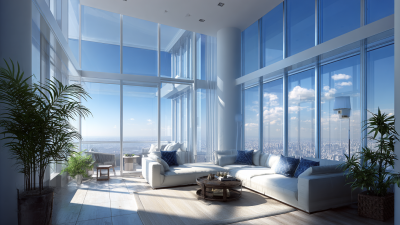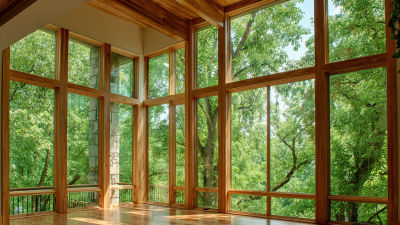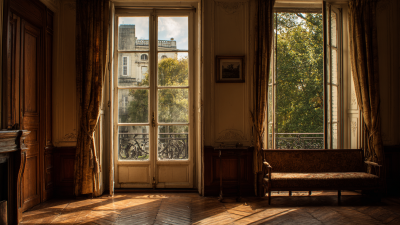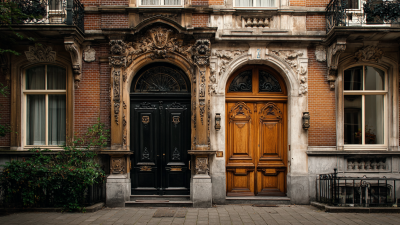The Benefits of Big Windows for Enhancing Natural Light and Aesthetic Appeal
In today's architectural landscape, the integration of natural light into living spaces has become a pivotal design element. Big windows stand out as an exceptional feature that not only enhances the aesthetic appeal of a home but also promotes a sense of openness and connection to the outdoors. According to renowned architect Emily Tran, "Big windows are not just a design choice; they are a lifestyle enhancement that brings nature indoors and brightens every moment of our lives." This perspective resonates with homeowners and designers alike, emphasizing the transformative power of expansive glass.
The myriad benefits of big windows extend beyond mere beauty; they significantly improve the quality of life by illuminating interiors and reducing the reliance on artificial lighting. Furthermore, large windows serve as a gateway to breathtaking outdoor views, seamlessly blending indoor elegance with the natural environment. As we explore the advantages of big windows, we will uncover how they can lead to energy efficiency, increased property value, and a deeper appreciation for the surrounding landscape, proving that they are indeed an essential aspect of modern design.

Table of Contents
[Hide]
Maximizing Natural Light: The Role of Large Windows in Home Design
Large windows have become a focal point in modern home design, primarily due to their ability to flood interiors with natural light. By maximizing the amount of sunlight that enters a space, these expansive glass installations not only contribute to the aesthetic appeal of a home but also create a welcoming atmosphere. Homeowners can enjoy views of beautiful landscapes, such as gardens or even iconic sights like Mount Fuji, enhancing the connection with nature and making the indoor space feel more alive and vibrant.
In addition to the visual benefits, incorporating large windows can significantly affect the overall ambiance of a home during darker seasons. Interior designers frequently recommend using large, floor-to-ceiling windows as a primary strategy for brightening spaces. These windows allow natural light to take center stage, transforming even the gloomiest days into bright, cheerful environments. Moreover, with the integration of biophilic design principles, large windows help blur the lines between indoors and outdoors, promoting wellness and tranquility within the living space.
The Benefits of Big Windows for Enhancing Natural Light and Aesthetic Appeal
| Feature | Benefit | Impact on Home Design | Energy Efficiency |
|---|---|---|---|
| Increased Natural Light | Creates a brighter and more inviting space | Enhances overall aesthetic appeal and ambiance | Reduces reliance on artificial lighting |
| Improved Mood | Natural light is linked to better mood and mental health | Promotes a sense of well-being in living spaces | Potentially lowers heating costs in winter |
| Enhanced Views | Brings the outdoors inside, showcasing gardens and landscapes | Transforms living areas into seamless transitions between inside and outside | May reduce energy costs due to natural climate benefits |
| Architectural Appeal | Large windows enhance the architectural style of the home | Adds character and visual interest to the home’s design | Can lead to better passive solar design strategies |
| Ventilation | Allows for better airflow and natural ventilation | Improves indoor air quality and comfort | Can help reduce reliance on air conditioning |
Aesthetic Appeal: How Big Windows Transform Interior Spaces
Large windows serve as a stunning design element that transforms interior spaces, offering an inviting and spacious atmosphere. By maximizing the amount of natural light that floods into a room, big windows create an open feel that enhances the overall aesthetic. The interplay of light and shadows throughout the day adds dimension and creates a dynamic environment. This connection with the outdoors not only brings the beauty of nature inside but also fosters a sense of tranquility, making spaces feel more vibrant and alive.
In addition to their practical benefits, oversized windows lend a modern and elegant touch to any interior design. They serve as focal points that draw the eye, enhancing the architectural features of a room. Whether framed with minimalist treatments or bold draperies, big windows can be personalized to complement any style, from contemporary to traditional. Furthermore, they provide fantastic opportunities for creating cozy reading nooks or stylish lounges, where occupants can bask in the warmth of the sun while enjoying unimpeded views. This seamless blending of interior and exterior environments showcases a home’s character and fosters an inviting ambiance that elevates daily living experiences.
Energy Efficiency: Benefits of Natural Light Through Larger Window Installations
Large windows are not only aesthetically pleasing but also significantly enhance energy efficiency in modern homes and commercial buildings. By allowing abundant natural light to flood indoor spaces, large windows reduce the reliance on artificial lighting, which can result in lower electricity bills. Sunlight can effectively illuminate rooms, creating a warm and inviting atmosphere while also diminishing the need for additional energy consumption during the day.
In addition to cutting energy costs, larger window installations can improve thermal performance. Well-designed windows equipped with energy-efficient glazing can help maintain indoor temperatures, reducing the need for heating in winter and cooling in summer. This thermal regulation contributes to a more comfortable living environment and supports sustainable energy practices. Overall, investing in big windows offers both aesthetic appeal and practical benefits, making it a wise choice for those looking to enhance their spaces while promoting energy efficiency.
Creating a Connection with Nature: Views and Landscapes Through Big Windows
Large windows serve as a bridge between indoor spaces and the natural world outside. By framing picturesque views and expansive landscapes, they create a seamless connection that enhances the aesthetic experience of any room. From the soft hues of a sunset to the dynamic colors of changing seasons, these windows allow occupants to immerse themselves in nature's beauty. This connection can significantly boost mental well-being, providing a calming effect that brings tranquility into everyday life.
Furthermore, big windows can transform a space by drawing in natural light, which not only brightens rooms but also highlights architectural features and decor. This influx of natural illumination can reduce the reliance on artificial lighting, creating an eco-friendly atmosphere. As light dances through the glass, it casts intricate shadows and patterns, adding depth and intrigue to a home. Ultimately, the integration of large windows is not merely about aesthetics; it fosters a deeper appreciation for the surrounding environment, enhancing the overall quality of life.
Design Considerations: Balancing Large Windows with Privacy and Functionality
When designing spaces with large windows, one must carefully consider the balance between open aesthetics and the need for privacy. Large windows can flood a room with natural light, creating an inviting environment. However, this openness may also expose the interior to prying eyes, potentially compromising the comfort and security of those inside. To mitigate this issue, architects and designers often employ strategic placements for windows, ensuring that they are situated in ways that maximize light while minimizing visibility from the outside. For instance, elevating the window height or incorporating frosted glass can provide serene light-filled interiors while maintaining seclusion.
Functionality is another critical factor in the design of large windows. It is essential to contemplate how these elements contribute to the overall purpose of the space. For instance, in private areas such as bedrooms or bathrooms, oversized windows can be paired with functional elements like sheer curtains or blinds, allowing for light control without sacrificing privacy. In communal spaces like living rooms, the design can embrace openness with strategically placed greenery or outdoor structures that provide natural privacy screens. By thoughtfully addressing these considerations, designers can create harmonious spaces that are both visually appealing and practical for everyday living.
Related Posts
-

Exploring Unique Alternatives to Traditional Big Windows for Modern Spaces
-

How to Enhance Your Home with Large Windows for Natural Light
-

Exploring the Future of Style Windows at the 138th Canton Fair 2025: Trends and Insights
-

How to Enhance Your Home Aesthetic with French Windows
-

Innovative Designs for Doors and Windows That Transform Spaces Globally
-

Top Strategies for Sourcing Stylish Windows in a Competitive Global Market